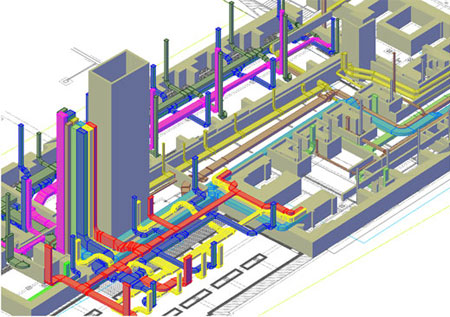Level 2 BIM is a managed 3D environment that can also use 4D construction sequencing and/or 5D cost information
A recent survey of U.K. construction experts on the use of Building Information Modeling (BIM) shows 64 percent believe the British government’s 2016 target to achieve Level 2 BIM capability on all central government infrastructure projects is “unachievable.”
BIM provides a common environment for all information defining a building, facility or asset together with its common parts and activities, including building shape, design and construction time, costs, physical performance, logistics and more.
Level 2 BIM is a managed 3D environment held in separate discipline ‘BIM’ tools with data attached. Commercial data is managed by enterprise resource planning software and integrated by proprietary interfaces or bespoke middleware. Level 2 BIM may utilize 4D construction sequencing and/or 5D cost information.
There can be several BIM models for a single project. For example, many construction trades such as structural engineering may develop models for their own purposes. A client may mandate the development of a single “combined model” incorporating the data of a number of authored models, for example of the key designers and subcontractors.
However, the survey found that 52 percent of respondents believe that “integrity of information inputted into construction models could be the greatest risk area for their organization.”
The survey canvassed 70 construction experts within the U.K. infrastructure industry, including main contractors, sub-contractors, trade contractors, material suppliers, professional services firms and construction clients. Most respondents were primarily design consultants (48 percent) and main contractors (22 percent).
The vast majority (94 percent) of respondents believe that the use of BIM requires a more collaborative approach between the client and construction team, and over a quarter (27 percent) cite the absence of collaboration as the most significant barrier to achieving Level 2 BIM capability in their organization.
“The overriding message from our survey points to greater collaboration if BIM is to be a success,” said Chris Hallam, partner in Pinsent Masons’ projects, construction and engineering team. “The problem is that the majority of construction contracts are not very collaborative. Risk tends to be allocated in a binary manner, with each party incentivized to look after its own interests – rather than the wider interests of a project. Because the parties’ interests are rarely aligned, this tends not to create an environment where true collaboration is possible – at least not if things go wrong. BIM, however, by its very nature requires a more collaborative environment.”
Survey’s top reasons for slow adoption of BIM:
- Lack of awareness/understanding of BIM within the organization
- Insufficient experience of BIM within our organization
- Lack of understanding of BIM within consultants employed by our clients
- Lack of understanding of BIM within sub-contractors/suppliers
- Lack of industry/Government guidance on BIM
- BIM perceived as irrelevant/insignificant to the organization and its clients
- Lack of willingness to invest in BIM by clients
- Expectation that cost of BIM should be met by our organization
- Absence of truly collaborative approach necessary for BIM






